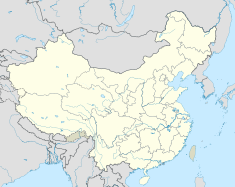Daqing Oil Field
| Daqing Oil Field | |
|---|---|
 Main Building of Daqing Oil Field Co. Ltd. | |
 | |
| Country | China |
| Region | Heilongjiang province |
| Offshore/onshore | Onshore |
| Coordinates | 46°36′N 124°54′E / 46.60°N 124.90°ECoordinates: 46°36′N 124°54′E / 46.60°N 124.90°E |
| Operator | Daqing Oilfield Company Limited |
| Field history | |
| Discovery | 1959 |
| Start of production | 1960 |
| Production | |
| Estimated oil in place | 16,000 million barrels (~2.2×109 t) |
| Recoverable oil | 3,600 million barrels (~4.9×108 t) |
This article needs additional citations for verification. (April 2017) |
The Daqing Oil Field (simplified Chinese: 大庆油田; traditional Chinese: 大慶油田; pinyin: Dàqìng Yóutián), formerly romanized as "Taching",[1][2] is the largest oil field in the People's Republic of China, located between the Songhua river and Nen River in Heilongjiang province. When the Chinese government began to use to pinyin for romanization, the field's name became known as Daqing.
Discovered in 1959 by Li Siguang, Wang Jinxi (who led No. 1205 drilling team) worked on this oilfield. This field has produced over 10 billion barrels (1.6×109 m3) of oil since production started in 1960. Daqing contained 16 billion barrels (2.5×109 m3) or 2.2 billion tons in the beginning; the remaining recoverable reserves are about 3.6 billion barrels (570×106 m3) or 500 million tons. Due to the rapid increases in production in its early days, Daqing was lauded by China's state media as a model industrial enterprise throughout the 1960s and 1970s. As of 2013 the field's production rate was about 800,000 barrels per day (130,000 m3/d).[3]
It is reputed that during the first two decades of the life of the field, as much as 90% of the oil was wasted.[4]
Daqing Oilfield Company Limited, based in Daqing, is the operator of exploration and development of Daqing Oilfield. From 2004, the company plans to cut its crude oil output by an annual 7% for the next seven years to extend the life of Daqing.[5]
Output of barrels of oil equivalent of the Daqing Field remained stable at over 40 million tons in 2012, while output at Changqing oil field was over 42 million tons, making it the most productive oil and gas field in China.[6]
Crude output from the ageing Daqing oilfield is in decline even though the CNPC deployed some non-traditional drilling techniques. In 2019, output fell to 30.9 million tonnes from 32 million tonnes in 2018. At its peak in 2008, output stood at 40 million tonnes a year.[7]
A new shale oil field was discovered in Daqing Oilfield in 2021, with an estimated geological reserve of 1.268 billion tons[8]
In popular culture[]
It is featured as a map in Battlefield 2.[9]
It was also featured in a dedicated part of the How Yukong Moved the Mountains documentary, "About Petroleum".[10]
See also[]
References[]
- ^ China today Archived 2007-09-29 at the Wayback Machine
- ^ New China's first quarter-century (1975) Archived 2008-12-01 at the Wayback Machine
- ^ Timmons, Heather. "The massive, aging oil fields at the heart of China's latest corruption purge". Quartz. Retrieved 2020-09-16.
- ^ James., Kynge (2009). China shakes the world : the rise of a hungry nation. London: Phoenix. ISBN 9780753826706. OCLC 302073511.
- ^ "Daqing Oilfield to Slash Output in 2004".
- ^ PetroChina Oil output in 2012
- ^ "China's Daqing to boost oil refining and petrochemical production - ET EnergyWorld".
- ^ "Major shale oilfield discovered in Daqing". english.www.gov.cn. Retrieved 2021-10-19.
- ^ Daqing Oilfields (PRC vs USMC), retrieved 2020-09-16
- ^ Ding, Gang (2019-09-16). Selected Essays on China's Education: Research and Review, Volume 1: Written and Oral Narratives. BRILL. p. 231. ISBN 978-90-04-40960-6.
- Oil fields in China
- Geography of Heilongjiang
- Daqing
